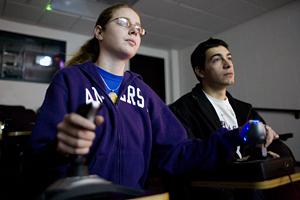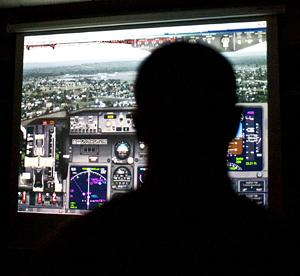By Katherine Duke '05
 |
The students in the Interterm course “An Introduction to the Principles, Practices, and Procedures of Turbine Flight” sat in a darkened room in Merrill, taking turns on a joystick and mouse, being pilot and co-pilot on Microsoft Flight Simulator X (FSX). Projected onto a screen at the front of the room were the switches, dials and lights of a Boeing 737 flight deck and a simulated view of the trees, buildings and waters around the Beef Island Airport in Tortola, British Virgin Islands. Rain was lashing the plane’s windshield, lightning crackled in the distance, and the students were about to undertake a perilous mission.
The course, sponsored for the past three years by the Department of Astronomy, began on Jan. 13 with a trip to Connecticut’s (real) Bradley International Airport, where a pilot showed the class the instruments and control surfaces of a Falcon jet. Over the next week and a half in Merrill, instructor Captain Henry Parker Hirschel—who also teaches the Interterm course on “Celestial Navigation” —used a small, colorful model of a 737 for visual demonstrations and also taught brief lessons on Newtonian physics and the evolution of flight simulation technology.
 |
But the bulk of class time was devoted to practicing on FSX, and the trickiest skill to learn was landing—that’s when most accidents happen. The students’ final challenge was to fly “a despondent Williams College varsity football team” from Tortola to St. Thomas in the midst of a thunderstorm. As Hirschel gave helpful reminders (“It’s not a video game.” “Up is this way.” “You don’t mumble in a cockpit.”) and sometimes hummed Wagner’s The Valkyrie, each co-pilot read through a checklist from the course flight manual to make sure that the plane and pilot were “good to go,” and the pilots did their best to guide the jet up off one runway, through the air and down onto the other—sometimes successfully, sometimes not. “Oh, the humanity!” Hirschel cried each time the computer showed the plane plowing into the asphalt or a tree. He kept a tally of these “hull losses” on the blackboard.
In the end, the count was 23 hull losses—an improvement over last year’s 27—and several safe journeys. While this course didn’t exactly provide the 2,000-plus hours of jet time required for real licensure to be a co-pilot, every student did step up, salute and receive a certificate of membership into the “Merrill Flyers of Amherst College.”